Demand for pea protein RTM dispersibility for shaker formats in Latin America is estimated at USD 420 million in 2025, with projections indicating a rise to USD 873.72 million by 2035, reflecting a CAGR of approximately 7.6% over the forecast period.
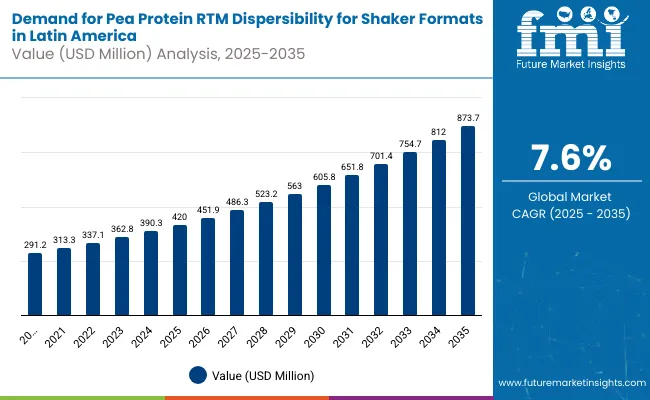
| Metric | Value |
|---|---|
| Industry Size (2025E) | USD 420 million |
| Industry Value (2035F) | USD 873.72 million |
| CAGR (2025 to 2035) | 7.6% |
This growth reflects both expanding consumer awareness of plant-based nutrition and increased per capita consumption of protein supplements across key urban centers. The rise in demand is linked to growing fitness culture adoption, heightened health consciousness, and evolving convenience preferences for on-the-go nutrition.
By 2025, per capita consumption in leading Latin American countries such as Brazil, Mexico, and Argentina averages between 0.8 to 1.2 kilograms, with projections reaching 1.6 kilograms by 2035. São Paulo leads among metropolitan areas, expected to generate USD 42 million in pea protein RTM sales by 2035, followed by Mexico City (USD 28 million), Buenos Aires (USD 18 million), Rio de Janeiro (USD 15 million), and Bogotá (USD 12 million).
The largest contribution to demand continues to come from flavored RTM powders, which are expected to account for 40% of total sales in 2025, owing to enhanced palatability, improved mixability profiles, and strong consumer preference for taste-forward formulations. By distribution channel, supermarkets and hypermarkets represent the dominant retail format, responsible for 42% of all sales, while health and nutrition stores and e-commerce platforms are expanding rapidly.
Consumer adoption is particularly concentrated among sports and fitness enthusiasts and health-conscious millennials, with urban density and disposable income emerging as significant drivers of demand. While price remains a consideration compared to whey protein alternatives, the average price premium has declined from 18% in 2020 to 12% in 2025.
Continued improvements in processing technology and local manufacturing capabilities are expected to accelerate affordability and access across middle-income households. Regional disparities persist, but per capita spending in emerging Colombian and Chilean cities is narrowing the gap with traditionally strong Brazilian and Mexican urban hubs.
The pea protein RTM dispersibility segment in Latin America is classified across several dimensions. By product form, the key categories include unflavored RTM powders, flavored RTM powders, fortified RTM powders with vitamins and minerals, and specialized RTM powders for sports and clinical applications. By distribution channel, the segment spans supermarkets and hypermarkets, health and nutrition stores, e-commerce platforms, gyms and fitness centers, and other specialty outlets. By flavor profile, formulations include chocolate-based, vanilla-based, berry and fruit-based, and other exotic flavor combinations. By consumer profile, the segment covers sports and fitness enthusiasts, health-conscious millennials, weight management consumers, and other specialized demographic groups. By geography, countries such as Brazil, Mexico, Argentina, Colombia, and other Latin American nations are included, with coverage across major metropolitan areas and emerging urban centers.
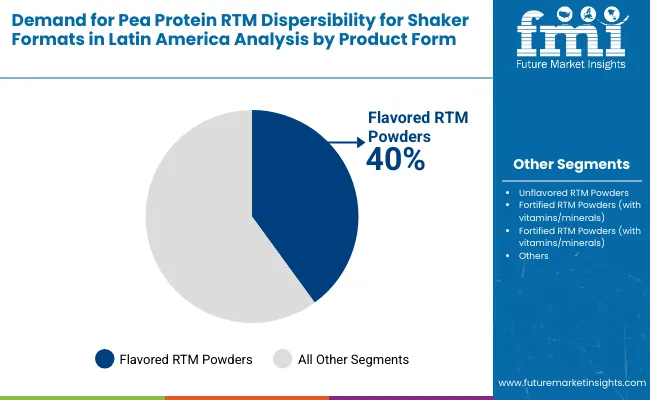
Flavored RTM powders are projected to dominate sales in 2025, supported by superior taste profiles, enhanced dispersibility characteristics, and consumer preference for ready-to-consume convenience. Other formats such as unflavored, fortified, and specialized powders are growing steadily, each serving distinct nutritional and application needs.
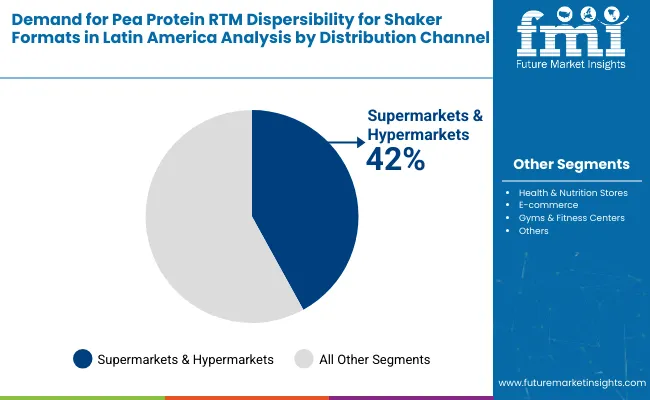
Pea protein RTM products in Latin America are distributed through a mix of traditional retail and specialized health channels. Supermarkets and hypermarkets are expected to remain the primary point of sale in 2025, followed by health and nutrition stores and e-commerce platforms. Distribution strategies are evolving to match consumer shopping behavior, with growth coming from both physical and digital formats.
Pea protein RTM products in Latin America utilize diverse flavor profiles, selected for palatability, cultural preferences, and masking of inherent pea protein taste characteristics. Chocolate-based formulations remain the most widely accepted, though vanilla and fruit-based alternatives are gaining momentum among specific consumer segments.
The pea protein RTM category appeals to a diverse consumer base across age groups, fitness levels, and health motivations. While usage patterns vary from performance enhancement to general wellness supplementation, demand is concentrated among three key demographic clusters. Each group brings distinct purchase behaviors, flavor preferences, and product expectations.
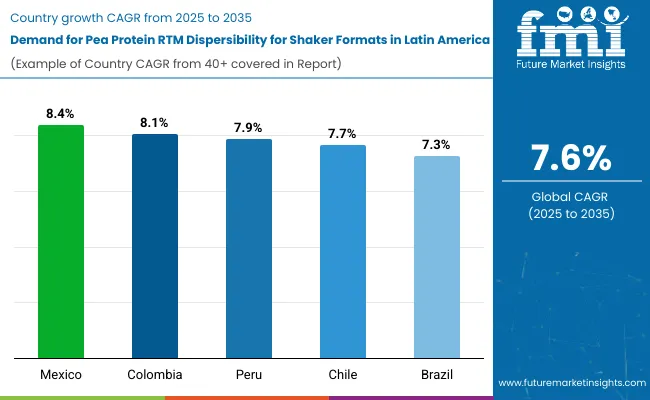
Pea protein RTM sales will not grow uniformly across every Latin American country. Rising fitness culture penetration and faster per-capita adoption in emerging economies give Mexico and Colombia a measurable edge, while mature Brazilian and other hubs expand more steadily from a higher consumption base. The table below shows the compound annual growth rate (CAGR) each of the five largest countries is expected to record between 2025 and 2035.
Between 2025 and 2035, demand for pea protein RTM products is projected to expand across all major Latin American countries, but the pace of growth will vary based on fitness culture adoption, retail infrastructure development, and baseline protein supplement consumption levels.
Among the top five countries analyzed, Mexico is expected to register the fastest compound annual growth rate (CAGR) of 8.4%, driven by rapidly expanding gym membership, growing middle-class purchasing power, and increasing health awareness among urban millennials. This acceleration is underpinned by improved distribution networks, local manufacturing investments, and strategic partnerships between international brands and regional fitness chains.
Colombia follows closely with an 8.1% CAGR, supported by strong economic growth prospects, increasing urban concentration, and developing retail infrastructure that facilitates premium product adoption. Both countries benefit from relatively lower baseline consumption levels, creating significant runway for category expansion as plant-based nutrition awareness increases.
Peru is forecast to grow at 7.9% CAGR, reflecting steady demand from emerging fitness communities in Lima and other major cities, supported by growing disposable income and health consciousness trends. The country's increasing integration with global supplement supply chains and expanding retail presence supports sustained growth.
Chile maintains a 7.7% growth rate, leveraging economic stability, high urban concentration, and sophisticated retail infrastructure. The country benefits from established health and wellness culture and growing acceptance of plant-based nutrition alternatives.
Brazil, while maintaining the largest absolute sales volume, is expected to grow at 7.3% CAGR, reflecting its mature supplement sector and higher baseline consumption levels. Growth will primarily come from flavor innovation, premium product tier expansion, and penetration into secondary cities beyond São Paulo and Rio de Janeiro.
Collectively, these five countries represent approximately 90% of Latin American demand for pea protein RTM products, but their individual growth trajectories highlight the importance of country-specific strategies in product formulation, pricing, and distribution approach.
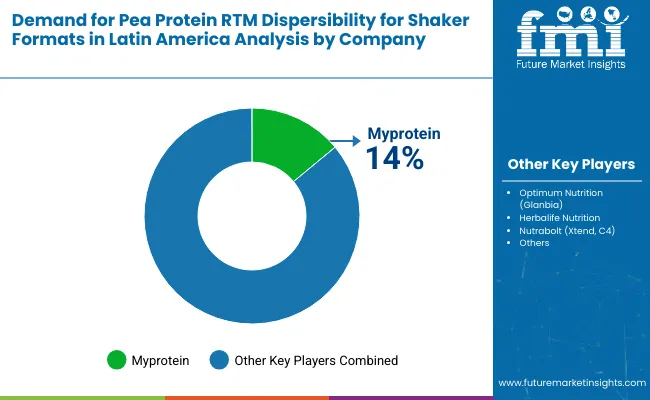
The competitive environment is characterized by a mix of established regional supplement manufacturers and emerging plant-based specialists. Distribution breadth and local manufacturing capabilities rather than product variety remain the decisive success factors: the five largest suppliers collectively reach more than 15,000 retail outlets across the region and account for a majority of health store and supermarket shelf facings in the category.
Myprotein represents the leading player with a 14% share, leveraging its global brand recognition and extensive e-commerce capabilities to reach Latin American consumers. The company's focus on competitive pricing, diverse flavor options, and direct-to-consumer distribution has enabled strong penetration across multiple countries while maintaining quality standards through established supply chain partnerships.
Nutrilatina represents the most established regional player, leveraging its extensive distribution network across Brazil and expanding presence in Argentina and Colombia. The company's focus on locally-manufactured formulations and culturally-relevant flavor profiles has enabled premium positioning while maintaining competitive pricing through supply chain optimization.
Vitafor, a Brazilian-based supplement manufacturer, has emerged as a key competitor through strategic partnerships with fitness influencers and gym chains. Its emphasis on sports nutrition credentials and performance-focused messaging has resonated strongly with the core sports and fitness enthusiast demographic.
EMS Pharma, while traditionally focused on pharmaceutical products, has successfully entered the pea protein space through its wellness division, leveraging existing retail relationships and medical credibility to target health-conscious consumers seeking clinically-validated formulations.
Atlhetica Nutrition has differentiated itself through premium positioning and innovative flavor development, targeting affluent urban consumers willing to pay premium prices for superior taste and dispersibility characteristics. The company's direct-to-consumer e-commerce strategy has proven particularly effective in reaching millennial demographics.
International players including Garden of Life, Vega, and Orgain are gradually entering the Latin American space through import partnerships and selective distribution agreements, bringing advanced formulation technologies and established brand credibility to compete with regional specialists.
| Attribute | Details |
|---|---|
| Study Coverage | Latin American sales and consumption of pea protein RTM dispersibility products from 2020 to 2035 |
| Base Year | 2025 |
| Historical Data | 2020 |
| Forecast Period | 2025-2035 |
| Units of Measurement | USD (sales), Metric Tonnes (volume), Kilograms per capita (consumption) |
| Geography Covered | Brazil, Mexico, Argentina, Colombia, Chile, Peru, Venezuela, Ecuador, and other LATAM countries |
| Top Countries Analyzed | Brazil, Mexico, Argentina, Colombia, Chile |
| Top Cities Analyzed | São Paulo, Mexico City, Buenos Aires, Rio de Janeiro, Bogotá |
| By Product Format | Unflavored RTM powders, Flavored RTM powders, Fortified RTM powders, Specialized RTM powders |
| By Distribution Channel | Supermarkets/hypermarkets, Health stores, E-commerce, Gyms, Others |
| By Flavor Profile | Chocolate-based, Vanilla-based, Berry/fruit-based, Others |
| By Consumer Profile | Sports enthusiasts, Health-conscious millennials, Weight management consumers, Others |
| Metrics Provided | Sales (USD), Volume (MT), Per capita consumption (kg), CAGR (2025-2035), Share by segment |
| Price Analysis | Average unit prices by product format and region |
| Competitive Landscape | Company profiles, private label strategies, regional vs. international presence |
| Forecast Drivers | Fitness culture adoption, health awareness, protein supplementation trends, disposable income growth |
By 2035, total Latin American sales of pea protein RTM products are projected to reach USD 873.72 million, up from USD 420 million in 2025, reflecting a CAGR of approximately 7.6%.
Flavored RTM powders hold the leading share, accounting for approximately 40% of total sales in 2025, followed by unflavored RTM powders at 35%.
Mexico and Colombia lead in projected growth, with Mexico registering a CAGR of 8.4% and Colombia at 8.1% between 2025 and 2035, due to expanding fitness culture and growing health awareness.
Supermarkets and hypermarkets are the dominant sales channel (42% share in 2025), followed by health and nutrition stores (25%) and e-commerce platforms (18%).
Major players include Myprotein, Nutrilatina, Vitafor, EMS Pharma, and Atlhetica Nutrition, with growing competition from international brands and private label offerings.






Our Research Products

The "Full Research Suite" delivers actionable market intel, deep dives on markets or technologies, so clients act faster, cut risk, and unlock growth.

The Leaderboard benchmarks and ranks top vendors, classifying them as Established Leaders, Leading Challengers, or Disruptors & Challengers.

Locates where complements amplify value and substitutes erode it, forecasting net impact by horizon

We deliver granular, decision-grade intel: market sizing, 5-year forecasts, pricing, adoption, usage, revenue, and operational KPIs—plus competitor tracking, regulation, and value chains—across 60 countries broadly.

Spot the shifts before they hit your P&L. We track inflection points, adoption curves, pricing moves, and ecosystem plays to show where demand is heading, why it is changing, and what to do next across high-growth markets and disruptive tech

Real-time reads of user behavior. We track shifting priorities, perceptions of today’s and next-gen services, and provider experience, then pace how fast tech moves from trial to adoption, blending buyer, consumer, and channel inputs with social signals (#WhySwitch, #UX).

Partner with our analyst team to build a custom report designed around your business priorities. From analysing market trends to assessing competitors or crafting bespoke datasets, we tailor insights to your needs.
Supplier Intelligence
Discovery & Profiling
Capacity & Footprint
Performance & Risk
Compliance & Governance
Commercial Readiness
Who Supplies Whom
Scorecards & Shortlists
Playbooks & Docs
Category Intelligence
Definition & Scope
Demand & Use Cases
Cost Drivers
Market Structure
Supply Chain Map
Trade & Policy
Operating Norms
Deliverables
Buyer Intelligence
Account Basics
Spend & Scope
Procurement Model
Vendor Requirements
Terms & Policies
Entry Strategy
Pain Points & Triggers
Outputs
Pricing Analysis
Benchmarks
Trends
Should-Cost
Indexation
Landed Cost
Commercial Terms
Deliverables
Brand Analysis
Positioning & Value Prop
Share & Presence
Customer Evidence
Go-to-Market
Digital & Reputation
Compliance & Trust
KPIs & Gaps
Outputs
Full Research Suite comprises of:
Market outlook & trends analysis
Interviews & case studies
Strategic recommendations
Vendor profiles & capabilities analysis
5-year forecasts
8 regions and 60+ country-level data splits
Market segment data splits
12 months of continuous data updates
DELIVERED AS:
PDF EXCEL ONLINE
Pea Protein Market Analysis - Size, Share, and Forecast Outlook 2025 to 2035
Pea Protein Ingredients Market Insights - Plant-Based Nutrition Growth 2025 to 2035
Chickpea Protein Market Analysis - Size, Share, and Forecast Outlook 2025 to 2035
Competitive Overview of Chickpea Protein Companies
Japan Pea Protein Market Analysis - Size, Share & Trends 2025 to 2035
Yellow Pea Protein Market Outlook - Growth, Demand & Forecast 2025 to 2035
UK Chickpea Protein Market Insights – Demand, Size & Industry Trends 2025–2035
USA Chickpea Protein Market Report – Trends, Demand & Industry Forecast 2025–2035
Pea Protein in Plant-Based Meat Analysis - Size Share and Forecast outlook 2025 to 2035
Pea Protein Demand in Dairy Alternatives Analysis - Size Share and Forecast outlook 2025 to 2035
Demand for Pea Protein Bakery Fortification in CIS Size and Share Forecast Outlook 2025 to 2035
ASEAN Chickpea Protein Market Trends – Growth, Demand & Forecast 2025–2035
Europe Chickpea Protein Market Outlook – Size, Share & Forecast 2025–2035
Australia Chickpea Protein Market Outlook – Demand, Trends & Forecast 2025–2035
Western Europe Pea Protein Market Analysis - Size, Share & Trends 2025 to 2035
Latin America Chickpea Protein Market Analysis – Demand, Share & Forecast 2025–2035
Demand for Textured Pea for High Protein Savory in EU Size and Share Forecast Outlook 2025 to 2035
Trends, Growth, and Opportunity Analysis of Pea Protein in South Korea Size and Share Forecast Outlook 2025 to 2035
Pea Grits Market Size and Share Forecast Outlook 2025 to 2035
Protein-Coating Line Market Forecast Outlook 2025 to 2035

Thank you!
You will receive an email from our Business Development Manager. Please be sure to check your SPAM/JUNK folder too.
Chat With
MaRIA